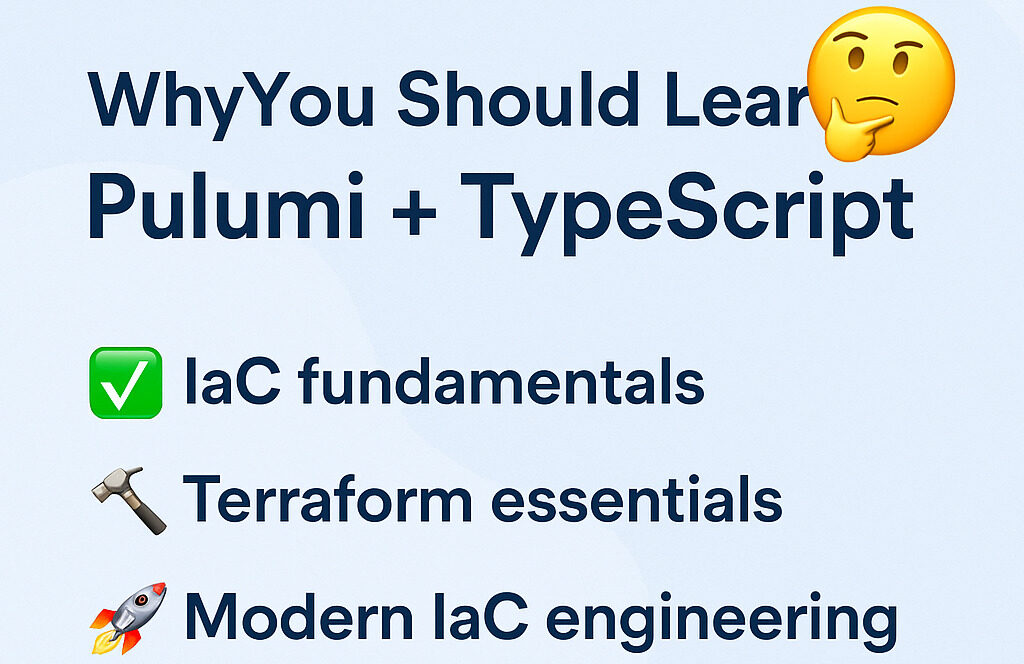1. What’s This All About?
If you’re working in DevOps, cloud infrastructure, or automation, one of the first big ideas you’ll run into is Infrastructure as Code (IaC).
In plain English, IaC means:
“You manage and provision your infrastructure using code – not by clicking around in a cloud dashboard.”
That might sound technical, but it’s essential. IaC makes your infrastructure version-controlled, repeatable, testable, and easier to manage as a team. Whether you’re deploying a single VM or an entire microservices platform, doing it with code is the modern way to work.
2. Terraform: The Gold Standard You Should Know First
Terraform, created by HashiCorp, is the current industry default for IaC. It’s open-source, widely adopted, and cloud-agnostic – used everywhere from startups to Fortune 500 companies.
✅ Why Terraform Is So Popular
- Declarative syntax: You describe what you want (e.g., “create an S3 bucket”) and Terraform figures out how.
- Multi-cloud support: AWS, Azure, GCP, Kubernetes, and many more.
- Huge community: Tons of modules, guides, Stack Overflow answers.
- Straightforward CLI:
terraform plan,terraform apply, and you’re up and running.
❌ But Terraform Has Its Limits
- You’re stuck with HCL, a domain-specific language. It’s readable but lacks advanced logic (e.g., real loops or conditionals).
- Code reuse is clunky, especially across larger teams or environments.
- Testing is hard – most people rely on manual validation or complex CI hacks.
- You can’t write unit tests the same way you can in a full programming language.
This is where Pulumi comes in.
3. Pulumi + TypeScript: Infrastructure as Software
Pulumi takes a different approach. Instead of using a special-purpose config language, Pulumi lets you define infrastructure using general-purpose programming languages like TypeScript, Python, Go, or C#.
If you’re already a developer, this is a game-changer.
🔥 What Makes Pulumi + TypeScript So Powerful
- You write actual code: loops, conditions, functions, modules, classes – all available.
- You get type safety with TypeScript: catch errors before they hit production.
- You can write unit tests for infrastructure using tools like
Jest. - You can re-use logic across projects or environments with proper abstraction.
- You integrate naturally with CI/CD, linters, and your IDE.
Example: S3 Bucket in Pulumi + TypeScript
import * as aws from "@pulumi/aws";
const bucket = new aws.s3.Bucket("myBucket", {
versioning: { enabled: true },
tags: {
Environment: "dev",
Project: "example",
},
});
That’s real code – not just YAML or HCL.
4. So, Which One Should You Learn?
Short answer: both.
Learn Terraform first because:
- It’s the standard in most companies.
- It’s easy to learn for beginners.
- It’ll help you land jobs, freelance gigs, or cloud certs faster.
But…
Learn Pulumi + TypeScript to:
- Push your IaC skills to the next level
- Build testable, reusable, and maintainable infrastructure
- Bridge the gap between developers and ops – especially if you’re full-stack or SRE
5. What Should You Actually Learn (Step by Step)
✅ Foundation: Infrastructure as Code Concepts
- What is “idempotency”?
- What is “state” and how is it managed?
- What does a typical deployment lifecycle look like?
🛠️ Terraform Basics
- HCL syntax: variables, resources, outputs
- Providers (e.g., AWS, Azure)
- State management (local vs. remote)
- Modules and workspaces
terraform init / plan / apply
🚀 Pulumi + TypeScript (Modern IaC Engineering)
- Project setup with
pulumi new typescript - Managing resources (AWS, GCP, Azure, etc.)
- Writing unit tests (with mocks)
- Organizing infrastructure with OOP principles
- Using
@pulumi/aws,@pulumi/gcp, etc. - Handling secrets, configs, and environments
6. Final Thoughts
You don’t have to choose between Terraform and Pulumi – the best engineers understand both and use them depending on the situation.
Use Terraform when:
- You’re in a team that already uses it
- You want something simple and reliable
- You’re working in regulated environments
Use Pulumi + TypeScript when:
- You want real programming power
- You need to build complex, testable IaC solutions
- You’re integrating closely with application code
🙋 Want to Learn More?
Let me know in the comments or send a message if you’d like:
- A walkthrough of a real-world Pulumi project
- A comparison of Terraform vs. Pulumi in CI/CD pipelines
- A GitHub repo with beginner-friendly IaC templates
Let’s make infrastructure testable, repeatable, and developer-friendly – one line of code at a time.
